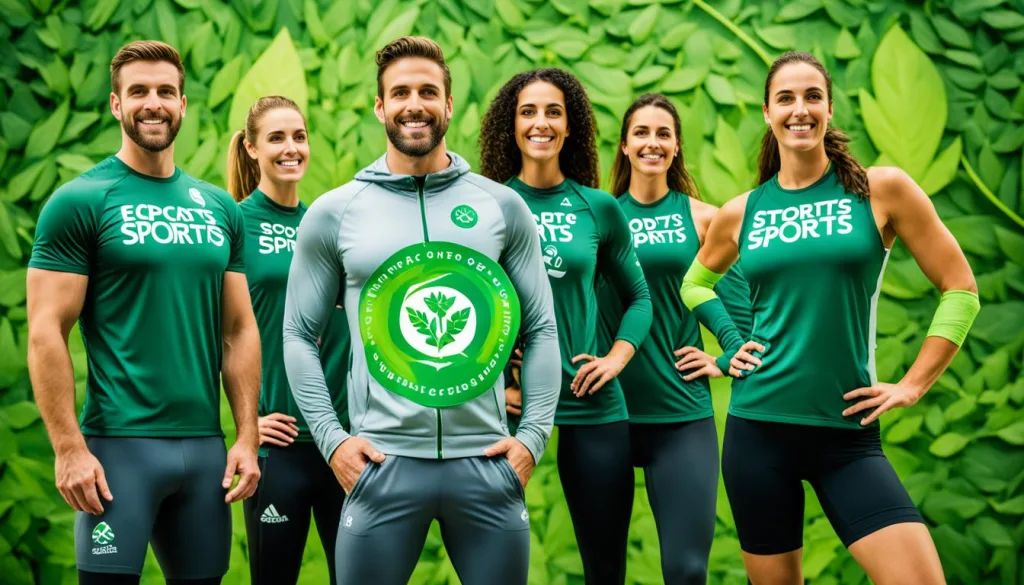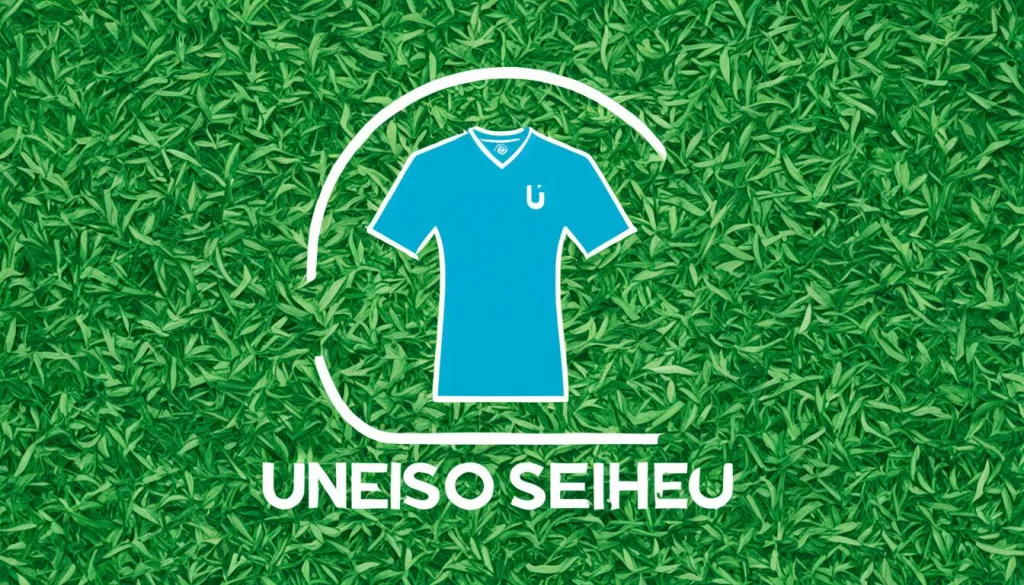Collaborative Efforts to Boost Sustainability in Sportswear
Connect With Us Today
Consider us for your next production run. Why wait? Send us your questions here.
Collaborative Efforts to Boost Sustainability in Sportswear are essential in today’s world. Many leading groups show us how to combine fashion with eco-friendliness. For example, CU Boulder is a trailblazer by joining the United Nations Sports for Climate Action Framework. They work with big names like FIFA and the NBA to cut down emissions1. This move meets the growing demand for sustainable fashion. It focuses on making eco-friendly sportswear that’s good for our planet without losing quality or performance2.
Sustainable sportswear brands are becoming more popular. They aim to use the power of sports to tackle climate change and reach millions1. IUPUI stands out with its eco-friendly buildings and efforts in tree saving and waste management3. This change in the sportswear field is about making products that don’t harm the earth. It also encourages a community of athletes, fans, and buyers to make choices that are better for our planet1.
Key Takeaways
- Collaborative Efforts to Boost Sustainability in Sportswear are vital in driving the industry towards greener practices.
- The sustainable fashion movement is gaining momentum with institutions like CU Boulder leading by example1.
- Eco-friendly sportswearis becoming a standard, with an emphasis on sustainable design and production2.
- LEED certifications and environmental accolades, such as those achieved by IUPUI, reflect the growing concern for sustainable infrastructure in sports and education3.
- Engagement with fans and consumers is critical in amplifying the impact of sustainability in sportswear brands1.
- Real-world applications of these initiatives are paving the way for a more sustainable future in sports and athletic apparel3.
Green Initiatives: The Front Runner in Sportswear Evolution
The sportswear industry is racing towards a sustainable future. Companies, nonprofits, and even governments are working together. They are creating a strong plan for green action in sports clothes and gear.
Green Sports Alliance: Pioneering Sustainability Through Sports
The Green Sports Alliance is leading the push for change. It convinces the sports world to adopt eco-friendly ways. This group works with teams and venues to lessen sportswear’s impact on the planet. It also boosts green activities in communities.
Eco-Friendly Sportswear Movements in Professional and Collegiate Arenas
Eco-friendly trends in sportswear are spreading. They now include college sports and their fans, not just the pros. These efforts push big companies to be more sustainable. They also encourage fans to choose greener options.
Assessment of Environmental Impact: Energy, Reuse, and Water Strategies
Brands are actively reducing their carbon footprints. They use less energy, save water, and reuse materials. This shows their commitment to protecting the planet.

Patagonia is a shining example of this dedication. Nearly all of their products use recycled materials4. This approach doesn’t hurt their quality or sales, which are almost 10% of the outdoor gear market4. They also use 100% renewable energy in their US operations, proving green changes are possible4.
But these efforts aren’t just in the US. Europe’s COI stresses the need for a worldwide sustainability standard5. It aims to mix Circular Economy principles with real-world market and tech improvements. A deal between China and the EU shows the world working together for a sustainable future5.
The work of the Green Sports Alliance, eco-friendly sportswear campaigns, and honest environmental reviews are making a difference. The sportswear sector is setting a strong example. It’s showing how to run towards a sustainable future, inspiring other industries to do the same.
Incorporating Sustainable Textile Manufacturing in Athletic Wear
The world of athletic wear is changing. Fashion, function, and sustainability are now key. Sustainable textile manufacturing is increasingly important. It satisfies eco-conscious buyers and captures a growing market.
The Role of Sustainable Supply Chain in the Sportswear Industry
Sustainable supply chains are vital in sportswear now, not just an extra. By 2019, eco-friendly athletic wear made up nearly 64.0% of global sales6. Meanwhile, high-end eco-friendly sports gear is also rising fast.
Advancements in Material Science for Eco-Conscious Athletic Wear
Innovations in material science are reshaping eco-friendly sportswear. In 2019, men’s wear led with 57.5% of global sales. However, women’s segments are set to grow fastest6. Shirts had a 35.1% revenue share, but yoga pants show the most growth potential6.
| Product Segment | 2019 Global Revenue Share | Expected Growth Rate (CAGR) |
|---|---|---|
| Shirts | 35.1% | Stable |
| Yoga Pants | Projected Increase | Highest Growth |
| Eco-Conscious Footwear | Expanding | Significant |
In 2019, physical stores were top revenue sources, holding 72.3% of global earnings. But, online shopping is quickly catching up, expected to soar from 2020-20276. North America was the biggest market in 2019. Yet, Asia Pacific is emerging as the fastest-growing area6. This shift points to changing consumer habits and wider access to sustainable products. Despite a drop in 2020, the market is set to climb to USD 117.4 billion by 2027. This shows the growing demand for sustainable athletic wear6.
Collaborative Efforts to Boost Sustainability in Sportswear
In our times, making sportswear sustainable is key. Brands are teaming up to make this happen. An impressive partnership is between UNESCO and Yunus Sports Hub. They aim to bring social and environmental care into sports.

UNESCO and Yunus Sports Hub: Bridging Social Business and Sport for Sustainability
Together, UNESCO and Yunus Sports Hub show how this teamwork works. They blend social business and sports to help the environment. Their work highlights the power of sports in achieving global sustainability goals.
Partnerships with WWF Italy: A Commitment to Eco-Friendly Fashion
WWF Italy also plays a big role in eco-friendly fashion. Their efforts change how the industry operates. They ensure fashion is both stylish and kind to our planet.
Sportswear events are now platforms for showing off green practices. Look at the Boston Marathon’s success. They managed to recycle a lot, with 79% of waste diverted7 at the Expo. Along the course, 80% was recycled7. They also turned 7.7 tons of cups into compost7. This shows how big an impact these efforts have.
| Event | Diversion Rate | Total Recyclable Waste |
|---|---|---|
| Boston Marathon Expo | 79%7 | N/A |
| Boston Marathon Course | 80%7 | 5.6 tons7 |
| B.A.A. 5K Event | 64%7 | N/A |
The efforts in sustainability are not just about waste. They also involve the community and giving back. The B.A.A. Non-profit Program has raised over $500 million since 19897. It supports over 200 organizations. In 2023, they started the B.A.A. Grant Program to help local communities through sports.
It’s more than a trend. The work of UNESCO, Yunus Sports Hub, and WWF Italy shows a victory for sustainability. It shows how competition and teamwork can create a positive change for our planet.
Understanding Consumer Impact on Sustainable Fashion Demand
The rise of sustainable fashion demand is fueled by changing consumer behavior. This shift is due to growing knowledge about the fashion industry’s harm to the environment. 67% of people surveyed say that using sustainable materials is a key factor in what they buy8. This care for the planet is linked to more talk about sustainability, hitting $2 billion in early 20228.
- Choosing brands that follow ethical practices is important to buyers, with 28% stopping support for brands with poor sustainability values8.
- Influencers have a big role in shaping opinions. Nearly half of shoppers trust these figures for advice on what to buy, highlighting their effect on sustainable fashion choices8.
There was a 54% increase in Media Impact Value (MIV) for sustainability chats in fashion for the first half of 2022 compared to the year before. This shows the pressure on fashion brands to take part in sustainability talks8.
| Year | MIV of Sustainability Conversations (Fashion) | Overall Value of Sustainability Conversations |
|---|---|---|
| 2021 | $1.3 billion | $1.3 billion |
| 2022 | $618 million | $2 billion |
The fashion world contributes significantly to pollution, being responsible for around 10% of global CO2 emissions and a fifth of yearly plastic use8. These stats make people think twice about supporting brands that ignore the environment.
With the environment at risk, 63% believe a brand’s commitment to being green is vital in their shopping choices8.
In the end, for the fashion industry, committing to green practices is more important than ever. Consumers prefer brands that are not just trendy but also considerate to ethical and sustainable ways.
Conclusion
The path to sustainability in sportswear is full of eco-friendly innovations. It’s also strengthened by firm collaborative efforts. The industry’s commitment to protecting our planet shows it’s more than a passing trend. This is a major shift towards a better, greener future. Toyota, as an example, has goals like cutting CO2 emissions by around 10%. They plan to do this by using recycled materials in car interiors 9. Changing materials and improving processes help cut down the carbon footprint. This encourages others to do the same.
Toyota’s work to reduce waste and save energy is impressive. They plan to stop using paper catalogs in Japan by 2025. This could save about 11,000 tons of carbon emissions every year9. It shows other companies how to be more careful with resources. Being recognized as a Sports Yell Company in Japan also highlights the value of employee health9. Winning such awards shows that being good to the environment also means taking care of your team.
It’s crucial for the sportswear sector to keep pushing for eco-friendly innovations and collaborative efforts. Toyota getting seen as a White 500 business and winning the Gold Prize in PRIDE INDEX shows sustainability matters on many levels. It involves culture, society, and including everyone. Balancing care for the environment, people, and making a profit shows a complete approach to growing sustainably. This balanced focus is sparking new ideas. It’s leading the sportswear industry to a future that’s fair, inclusive, and kind to the planet9.
FAQ
What are some collaborative efforts to boost sustainability in the sportswear industry?
How is the Green Sports Alliance pioneering sustainability through sports?
What are some eco-friendly sportswear movements in professional and collegiate arenas?
How is the environmental impact of sportswear production assessed?
What is the role of sustainable textile manufacturing in athletic wear?
Why is a sustainable supply chain important in the sportswear industry?
What advancements have been made in material science for the development of eco-conscious athletic wear?
How do UNESCO and Yunus Sports Hub collaborate to bridge social business and sport for sustainability?
How do partnerships with WWF Italy contribute to eco-friendly fashion?
How does consumer behavior impact the demand for sustainable fashion?
Why is consumer education and awareness important in driving sustainable fashion demand?
Source Links
- https://www.colorado.edu/today/2019/05/13/cu-boulder-athletics-signs-un-agreement-boosting-sustainability
- https://www.craftsportswear.com/global/about-us/sustainability
- https://news.iu.edu/live/news/24920-the-inaugural-indianapolis-sustainability-summit
- https://www.cascade.app/studies/patagonia-strategy-study
- https://www.mdpi.com/2071-1050/11/3/635
- https://www.grandviewresearch.com/industry-analysis/sustainable-athleisure-market
- https://www.baa.org/about/sustainability
- https://www.forbes.com/sites/forbescommunicationscouncil/2023/01/02/the-state-of-sustainability-in-the-fashion-industry-and-what-it-means-for-brands/
- https://global.toyota/en/sustainability/index.html
Latest News
How Collaboration Shapes Consumer Preferences in Sportswear
Navigating Consumer Rights and Warranties in Sportswear Sales
Artificial Intelligence in Fashion Forecasting and Trend Analysis
The Shift Towards Inclusive Sizing in Sportswear: Consumer Reactions
The Global Expansion of Luxury Sportswear Brands
From Sketch to Gym: The Design Process of Fashionable Sportswear
Understanding the Role of Trade Associations in Sportswear Compliance
How Economic Trends Influence Consumer Spending on Sportswear
Learning from Successful Global Market Entries
Best Practices for Managing Cross-Cultural Teams
Using Technology to Fight Counterfeit Fashion Products
Carbon Nanotube Fabrics for Superior Strength and Flexibility
The Growth of Fitness Tracking Apparel in Health and Wellness
Exploring the Influence of Social Proof in Sportswear Purchasing
Strategies for Managing Compliance in a Multinational Operation
Trends in Global Footwear: Performance Meets Lifestyle
The Role of Artificial Intelligence in Tracking Supply Chain Operations
Evaluating the Success of Sportswear Collaborative Projects
Evaluating the Potential of Emerging Markets
Global Shifts Towards Gender-Neutral Sportswear
Share This Article
Latest Articles



















